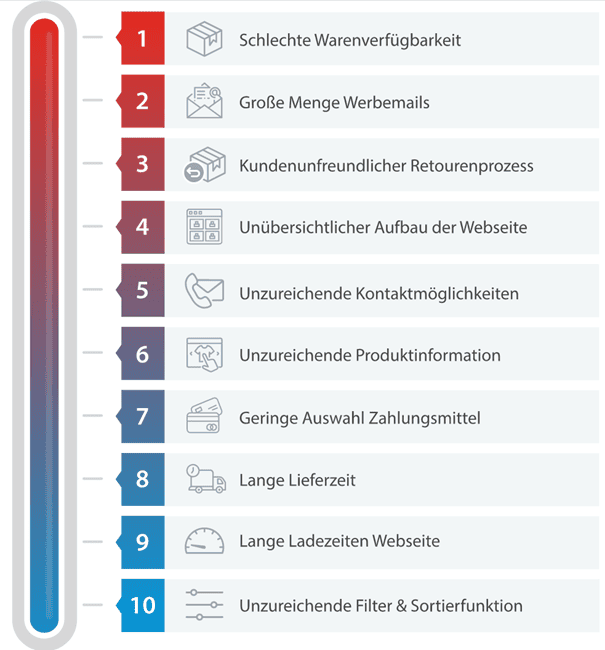The online business is booming. There is almost nothing that cannot be purchased online. Companies employ their own teams that continuously work on improving their online shops, understand customer needs and develop short-term solution strategies. Nevertheless, the question arises as to how customers experience and perceive online shopping. Which aspects of the buying process can cause customer frustration? At what point do customers get so frustrated that they abandon the purchase or switch providers? What strategies can companies use to counteract this and thus retain their customers?
According to a current study by elaboratum and Trusted Shops from 2020, there are typical moments of frustration for customers who are actually known, but to which perhaps too little attention has been paid so far. In the study “The E-Commerce Frustration Barometer", 1,200 participants and 500 shop operators were asked about their greatest pain points.
The most annoying situations from the customer's point of view
The greatest potential for frustration for customers can be seen above all in the procedural area. Customers expect goods to be available and are frustrated when items cannot be delivered. If the desired item has finally arrived and unfortunately does not please the customer as expected, a time-consuming returns process annoys the customer. In case of doubt, the customer can only contact the retailer personally. Here the customer expects simple communication channels that are tailored to his needs, but do not always meet these expectations. One of the most important marketing tools is the newsletter. However, if a company sends (too) many advertising e-mails, the customer is simply annoyed by the flood of advertising instead of knowing that they are looked after and understood all round.
A clear structure of the website is also important. Customers want to be able to click through to the desired product intuitively and quickly without being misled. Online retailers in particular with an extensive and complex range have to struggle with this aspect. Nevertheless, the problem is only ranked 4th among the most frustrating situations and is thus well behind the procedural issues and advertising emails.

Companies need to question themselves
At the same time, 500 companies, regardless of customer needs, were asked what they see as the greatest levers to avoid customer frustration and to retain customers in the long term. It becomes clear that there is a discrepancy between how companies perceive themselves and how they are perceived by others. For the companies, the biggest shortcomings are:
Insufficient contact options (only 4th place for customers)
Poor availability of goods (only 1st place for customers)
Long loading times and
A long delivery time (only place 8 and 9 for customers)
Solution approach: Take the perspective of the customer
All points of criticism were mentioned by both customers and companies, but with different weightings. This survey shows that customer proximity and customer surveys are the most important tools for companies to uncover weaknesses and potential for improvement. A simple means is a survey on the website, in which pre-process topics can be queried easily and quickly, especially with prospects and customers. In order to query the after-sales experiences of the customers in a structured way, however, a survey can be sent out some time after the product has been sent (and thus the product has been used). But page views of FAQ topics or the evaluation of the online search on the website also provide information about customer questions and moments of frustration. These key figures are already available and usually only need to be evaluated in a targeted manner.
The prioritization of the relevant topics should be based on customer needs. Also "unloved", especially procedural topics are important drivers. The reasons for returns usually also contain valuable information that comes directly from the customer. Even more complex adjustments to business processes are worthwhile if you work on the customer's biggest pain points and can thus optimize the conversion rate.
Not all measures can and do not have to be implemented immediately. Take the measures with the greatest customer benefit first and prioritize them based on the effort. However, don't always put off complex adjustments into the future. Your customers will thank you and, above all, reward a continuous optimization process with trust and loyalty.
We at communicode are happy to support you in optimizing the user experience in your online shop and uncovering further development potential. Our consultants carry out a complete shop analysis and help you turn the pain points into conversion boosters. Talk to us and together we will help your online shop to be even more successful.